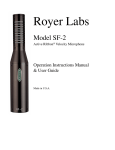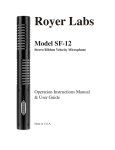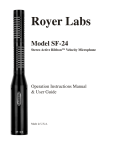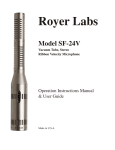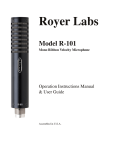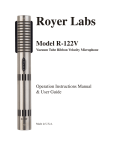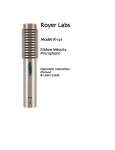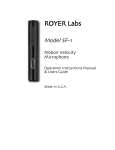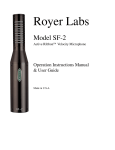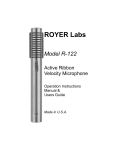Download royer SF-2 User guide
Transcript
ROYER Labs Model SF Stereo Ribbon Velocity Microphone Operation Instructions Manual & User Guide Made in USA TA BLE OF C ONTEN TS Model SF Stereo Ribbon Velocity Microphone Table of Contents page 1 Introduction page 2 Description page 2 Users Guide page 2 Amplification Considerations page 3 Recording Techniques: -Conventional X-Y Recording page 6 -Mid-Side (M-S) Recording page 7 Applications page 9 Care and Maintenance page 11 A Little Bit of History page 12 Features page 13 Specifications page 13 Wiring Diagram page 14 Frequency Response and Polar Pattern page 14 Warranty page 15 1 Introduction Congratulations on your purchase of a Royer Labs model SF-12 ribbon microphone. The SF-12 is a handcrafted precision instrument capable of delivering superior sound quality and overall high performance. This operator’s manual describes the SF-12, its function and method of use. It also describes the care and maintenance required to ensure proper operation and long service life. The users guide section of this manual offers practical information that is designed to maximize the performance capabilities of this microphone. Royer Labs products are manufactured to the highest industrial standards using only the finest materials obtainable. Your model SF-12 went though extensive quality control checks before leaving the factory. Normal care, given to any quality instrument, is all that is required to assure years of trouble-free service. Please read the manual thoroughly in order to become familiar with all of the SF-12’s capabilities. It will assist you in making the most of its superior acoustic properties. This owner’s manual is a handy reference guide and we suggest you refer to it whenever questions arise on the use and care of your SF-12 ribbon microphone. Description The SF-12 is a compact stereophonic ribbon microphone array consisting of two (2) matched microphone elements that are placed one above the other. When held vertically, connector down and the “ROYER” logo facing the sound source, the upper microphone is the right channel and the lower one is the left channel, from the perspective of someone behind the mic. The microphone elements are each bi-directional (figure-eight) and may be addressed from either side with equal sensitivity. The in-phase signals are achieved when the microphone is addressed from the front, as indicated by the “ROYER” logo. If, however, the microphone is hung on its cable, the connections to the preamplifier should be reversed since what was the left transducer is now responding to signals from the right and vice versa from the perspective of someone at the microphone location. Your SF-12 is equipped with a 5-pin XLR extension cable and an adapter that fans out to twin 3-pin male XLR connectors. As shipped from the factory, the connectors are marked “upper” and “lower” since calling them ‘”left” and “right” could lead to confusion. The SF-12 is tolerant of shock and vibration, and is unaffected by changes in temperature or humidity. Normal care appropriate to any precision instrument is all that is required to assure years of trouble-free service. User Guide Using the SF Ribbon Microphone Operation The SF-12 is a versatile device capable of accurate sound reproduction. There are a few important facts about ribbon microphones that are key in understanding how to use them 2 intelligently. 1. The SF-12 is a side-address, bi-directional microphone and the rejection in the “dead” areas is very strong. Due to this directionality, ribbon microphones should be placed at 1.3 times the distance normally used with omni-directional microphones, or about the same distance used for cardioid microphones. This method is used to achieve the same ratio of direct to reflected sound. 2. In the horizontal plane, ribbon microphones do not discriminate against the “highs” off axis, nor do they boost them on axis. Therefore, several instruments or vocalists can be placed in front of the microphone without favoring the performer in the center of the group. Several performers can be grouped at both the front and the back of the microphone, with one proviso; since the outputs are out of phase at the front and back of the microphone, cancellation can result if two tenors are placed on opposite sides at equal distances and are singing in unison. Therefore, listen to the feed before committing to it. 3. The Royer model SF-12 requires no power supply and is safe to use on consoles with phantom microphone powering, provided that the cabling is done properly. It should be noted that not all ribbon microphones are compatible with phantom-powering systems, so check the manufacturer’s recommendations before using other ribbon microphones. Faulty or improperly wired cables could also cause problems with your SF-12. 4. Never attempt to “test” the SF-12 or any ribbon microphone with an ohmmeter. A blown ribbon could result. 5. Always provide adequate protection for your SF-12, or any ribbon microphone for that matter. If the microphone is to remain set up on a stand when not in use, place a “mic sock” over it until it is to be used. Do not carry the microphone around without placing a “mic sock” over it. Failure to follow this common-sense practice may yield a stretched ribbon and compromised performance! Amplification Considerations The performance of a ribbon microphone is directly affected by the choice of microphone preamplifier it is paired with. With so many mic preamps on the market, how do you select one that gives the best possible performance with a ribbon microphone? Additionally, what kind of performance can we expect from the preamplifiers built into our mixing desks? While most preamplifiers will handle ribbon microphones well in most recording situations, some preamps that work perfectly well with condenser or dynamic mics may prove to be poor performers with ribbons. To begin with, we must understand the fundamental differences between ribbon microphones and other popular types, namely condenser and moving coil dynamics. A ribbon microphone is actually a dynamic microphone that uses a flat, extremely low mass ribbon element, rather than a coil/diaphragm assembly. For this writing, any mention of 3 “dynamic” microphones will relate to moving coil dynamics. All condenser microphones have a built in preamplifier called a head amp and therefore put out a hefty signal. Because the signal is buffered through the head amp, the output impedance is rather low and less affected by the input impedance of the microphone preamp. Most dynamic (moving coil) microphones generate a healthy enough electrical current to work well with a variety of preamps, and their limited frequency response characteristics make mic loading less of a concern. Ribbon microphones generate a highly accurate signal, but the average ribbon mic generates approximately 20dB less gain than that of condenser microphones. Remember, the ribbon transducer does not have the benefit of a condenser mic’s built in “head amp”, so a ribbon microphone relies solely on the microphone preamp for all its gain! The so called ideal preamplifier is the proverbial “straight wire with gain”. This may be considered the technological ideal and does not include “coloration” as a desirable feature. However, coloration is often desirable and has given rise to the popularity of certain preamps and even preamp stages in mixing desks. Neve® preamps and the famous Trident® A Range mixing console are highly praised for their classic sound. So what should we use with our beloved ribbon microphones? The features that translate into top performance for a ribbon microphone are the following: 1. Lots of gain! A ribbon microphone works best with preamplifiers that have at least 60-70 dB of maximum gain. 2. Low noise is a must! With this much gain being required for efficient operation of a ribbon microphone, the noise characteristics of the preamp play a pivotal role in overall performance of the captured acoustic event. 3. Load characteristics: A suitable preamplifier should have input characteristics that impose the least amount of loading to the ribbon element. In other words, the input impedance should be high enough that its effect on the performance of the mic is negligible. A good rule of thumb is to have a preamplifier with input impedance at least five times the impedance of the microphone. For example, if the mic is rated at 300 Ohms (as Royer’s are), the preamp should have an input-impedance of at least 1500 Ohms. If the impedance of the preamp is too low, the microphone will lose low end and body. 4. Transparency: A good preamp should sound natural with no edginess. Tube preamps sound warm, yet wonderfully transparent. Transformer coupled preamps sound punchy. When recording with condenser or dynamic microphones engineers often choose mic preamps that help “warm up the mic”, but warming the signal up does not need to be a consideration with ribbon mics because they are by nature warm and realistic sounding. At this point personal taste should prevail over anything. Stereo Microphones and Ground Loops Some preamplifiers are prone to developing ground loops when used in conjunction with 4 stereo or multi channeled microphones, such as the SF-12. Ground loops can develop in the preamplifier with any stereo microphone, regardless of the type (i.e. condenser, dynamic, ribbon). A ground loop manifests itself as unwanted noise, buzz or hum (usually 120 Hz). The condition is brought on when the left and right transducer elements are plugged into two inputs of a stereo or multi-channel preamplifier. The pair of three-pin male XLR connectors of the stereo microphone cable usually shares Pin-1 as ground, so they are grounded to each other through the cable set. If the grounding scheme within the preamplifier is poorly designed, or the distances to internal ground are too great, a ground loop develops. The problem may be more apparent with ribbon microphones because of the high gain required for proper operation. You can perform a simple test to check for this condition (preferably done with a pair of headphones to avoid feedback). Plug one side of the stereo microphone into either preamplifier input. Listen to the output of the preamp. All should be quiet except for the mic signal. Now plug the second side into the next preamplifier input. If a noise or buzz develops, you have a ground loop. The ground loop may be very slight or more pronounced, depending on the preamp. Battery powered preamps usually do not exhibit this problem, and neither do well designed, line operated mic preamps. The simple fix is to disconnect one of the microphone’s two Pin-1 ground connections. A better method is to make a small ground lifter out of a male-female XLR barrel adapter. Switchcraft makes a very nice one and it takes less than five minutes to wire it up. Simply connect Pin-2 to Pin-2, Pin-3 to Pin-3, and leave Pin-1 disconnected. Correcting the problem at the preamplifier would be preferable, but is often more difficult and/or expensive. In conclusion, try to find the best preamp you can afford that has good gain characteristics and low noise. Coloration is optional. Equalization and Ribbon Microphones One of the great strengths of ribbon microphones is how well they take EQ. Even with substantial amounts of equalization, ribbons retain their natural, “real” quality. For example, when a lead vocal is being performed on a ribbon microphone, you can actually boost the upper end frequencies to the point where the ribbon mic emulates the performance curve of a condenser mic with excellent result. This is not to say that a ribbon microphone can replace a quality condenser mic, but the EQ friendliness inherent in ribbon microphones does allow for an enormous amount of flexibility. The reason that ribbon mics take EQ so well is because of their inherent low self-noise (less than 15 dB) and unusually smooth response characteristics. Dialing in high amounts of equalization on condenser or dynamic microphones also means dialing in extra amounts of the microphone’s distortion products and self noise; garbage that contributes to an unnatural, unpleasant sound. Because distortion and self-noise are almost non-existent in ribbon microphones, high levels of EQ can be used without adding harshness or excessive noise. 5 Hum Noise and Mic Orientation All dynamic microphones, including ribbons, utilize powerful magnets in their motor assemblies and matching transformers, and are, to some degree, susceptible to picking up stray alternating magnetic fields. Power transformers (such as those found in guitar amplifiers) and alternating current motors are the most likely sources of radiated noise. Building wiring and electrical utility transformers are other likely sources. A welldesigned microphone provides shielding to minimize the effects of stray magnetic radiation. In some cases complete isolation is impossible and the result is usually hum or buzz. Ribbon microphones can potentially manifest this condition to a greater degree because of their higher gain requirements. With vintage ribbon microphones, that employ large bulky magnet structures, the problem can be worse. Royer SF-1 and SF-12 microphones are designed to minimize the effects of unwanted radiation by integrating the transducer barrel as part of the magnetic return circuit. With this design, the barrel housing the transducer serves to complete the North-South magnetic return and neutralizes the effects of outside magnetic radiation. The SF-1 mono and SF-12 stereo ribbon microphones go one step further by incorporating toroid impedance matching transformers, which have a natural ability to repel magnetic radiation. Dynamic and ribbon microphones are passive devices, meaning they incorporate no external or internal power supplies and have no head amplifier and therefore cannot produce hum on their own. Unwanted noise (hum) can only come from an external source. Fortunately, there is a simple procedure that can be used to identify the source of the noise and eliminate it. Repositioning a dynamic and ribbon microphone is the number-one way to get rid of unwanted noise. If hum is detected, it means that the microphone is in the proximity of an alternating magnetic field. While listening (preferably with headphones) to the mic, move it around. The mic will “find” the noise source quite easily. If you are miking a guitar amplifier and suspect the amplifier’s power transformer may be the source of unwanted noise, move the mic around the amp. You will probably find that the noise is louder as you approach the amplifier’s power supply and quieter when you move it away. Eliminating the noise can be fairly simple and requires finding the “null” point of the noise. The “null” point is the position that places the microphone’s magnetic components away from the lines of radiation. Simply rotating the microphone slightly is many times all that is required to cancel out the noise. This is similar to the procedure guitarists use to eliminate noise from single coil guitar pickups. There will be a “magic position” where the noise disappears completely. Finding the exact position that also provides acceptable acoustic placement of requires a little practice, but the results are well worth the time. Recording Techniques Conventional (XY) Recording Orientation of the SF-12 microphone is such that the “ROYER” logo should always face the sound source to avoid inadvertent phase reversals. When the microphone is aimed as described, the center stage is picked up equally (3dB down) by both transducers. Their included angle of 90 degrees produces a continuous 6 sound curtain with sources outside this included angle appearing to be outside of loudspeaker placement. Figure 1 shows the alignment of polar patterns when the microphone is oriented this way. Because of the “togetherness” of the transducers, sound will arrive at both microphone elements at the same time. This means that the two channels can be summed to mono with no comb filter effects, and room reverberation (undesirable in mono) is cancelled to a surprising degree. Since arrival time differences are not available as aural stereo cues, how does this microphone produce stereo? It does so through variations in the intensity of the sound striking the ribbons. These intensity differences are a function of the right angle at which sound strikes the ribbon. The polar pattern shown in Figure 2 will clarify this. None of this would be possible if the SF-12 didn’t exhibit excellent frequency response regardless of the angle of sound striking the ribbons. Midside (MS) Recording Based on what you’ve learned so far, you can now use the SF-12 to make superb stereophonic recordings. What follows is a description of another recording technique, which adds a great deal more flexibility. All we can do here is give you an intuitive feel for this subject, but it can get you started. In the microphone placement we showed originally each ribbon is aimed at 45 degrees from center stage. The angle between the ribbons is 90 degrees, with center stage “splitting the difference”. Now rotate the microphone 45 degrees counter-clockwise as in Figure 3. Notice that the upper ribbon is aimed directly at center stage, and the lower ribbon is 90 degrees to center stage. We call the microphone aimed at center stage by a variety of names; mid, mono, (M). The other unit in our package, now aimed at 90 degrees to the sound source at center stage can be called a number of names as well; side, stereo, (S). Because of the alignment of the S microphone, sound from center stage will not be reproduced by this microphone element. This is because of the bi-directional nature of the pickup pattern. Some of the sound may try to move the ribbon to the left, but just as much sound will try to move the ribbon to the right, resulting in cancellation of the sound. Figure 3 Imagine now that the sound source has moved around so that it is all the way to the right of the microphone rather than in 7 front of it as before. Now the S microphone will respond to the source, but the M microphone will not. If the sound source moves to the left of the microphone, again the S microphone will respond but the M unit will be silent. The important fact to note is that the output of the S microphone will be 180 degrees out of phase to what it was when the source was at the right. Please keep this in mind, because it’s crucial. Examine the block diagram of Figure 4a. Note that the outputs of the two microphone transducers fan out to four separate mixer inputs. For our purposes we will assume that the top transducer of the SF-12 is the M microphone. Its preamplifier is so wired as to feed equal signals to both “L” and “R” output busses. Note that if nothing else is connected, the signal from this preamplifier will produce a monophonic, center channel signal. Figure 4a Notice that the preamplifier associated with the S element feeds two more inputs of your mixer, but that the phase has been reversed at position 4. The in-phase signal is assigned to the “left” channel and the reversed phase signal feeds the “right” channel. If only the S microphone is connected a monophonic signal results, but it will not be centered because the two channels are not properly phased. If your preamplifier lacks the ability to invert phase here is a handy circuit to build an invert phase adapter. The adapter can be built into a Male/Female Switchcraft barrel, or use a piece of cable and 2 connectors —1 male and 1 female. For a start, set up your system so that the signal from the S setup will produce the same signal level as the M signal, given the same level with respect to the two transducers. Suppose we again move our sound source in such a way that it is right in front of the M microphone. We hear a monophonic signal. No signal is produced by the S microphone 8 for reasons already stated. Now we move the sound source to the “left”. The signal falls off somewhat as heard by the M microphone, but picks up at the S microphone. Because of the electrical phase of this signal, it adds to the M signal feeding the “left” channel, making the sound appear to be coming from the left. Signal also feeds the “right” channel, but out of phase with respect to the M signal that also feeds the “right” channel. Thus, while the “left” channel experiences an increase in output, the “right” channel loses signal and this adds to the feeling that the sound source is truly at the “left.” Now we move the sound source to the “right” of the SF-12. As before, signal reaching the M microphone decreases in level, while the signal at the S microphone increases. Remember, we are talking about a bi-directional ribbon. The phase of the sound source at the S microphone is opposite to what it had been when the source was located at the “left” of the microphone. The combination of the reversed phase from the microphone and the inverted phase feeding the “right” channel means that the signal is now in phase with the “right” portion of the M signal. It is, however, out of phase with respect to the M signal feeding the “left” output channel. With the increased output on the “right” channel, coupled with the decreased output on the “left” channel, our sound source appears to be on the “right” channel, just as it is supposed to be. If we remove the S signal, we have pure monophonic sound. As we add more S signal, stereo appears. If we make the level of the S signal equal to that of the M signal, we will recreate the sound stage. If we add more S than M, we make the stage wider than life. That might come in handy if stereo was insufficient in the live situation. If the recording had been conventional, little could to be done to improve matters. It is often helpful to make a recording with the M signal fed into the recorder left channel and the S signal on the right channel. Later, in the calmer light of the control room, you can connect the recorder’s outputs as you did the microphone elements in our discussion. Not only can you determine the nature of the reproduced soundfield but you can treat the S signal in other ways. For instance, suppose you have a disk-recording situation in which the vertical information is such that groove lifts tend to occur. You can take the S signal, limit it, equalize it and feed it to your mixer as described. Almost magically, the vertical problems have vanished and the stereo effect is still excellent. Space does not permit a fuller discussion of the M-S intensity stereo format, first described by Alan D. Blumlein over 50 years ago. We suggest the following reading on the subject: W. Dooley & R. Streicher “M-S Stereo: A Powerful Technique for working in Stereo” J. Audio Eng. Soc., Vol. 30 pp.707 (1982 Oct.) Applications The SF-12 combines high quality audio performance with unbeatable stereo separation and imaging. The microphone is housed in a trim package, free of the cluttered look 9 produced by switches and adjustments. Its small size and matte black chrome finish create a minimum disturbance of the visual field, especially important where the microphone must not obstruct the view of an audience or of a motion picture or TV camera. The SF-12 is easy to use, robust and reliable. Neither temperature nor humidity affects it. SF-12 has numerous applications. Along with its useful-ness as an overhead drum mic, a stereo acoustic piano or guitar mic, and organ recording, it can be applied to motion pictures because of its natural stereo capabilities. It is also very useful for recording ensembles such as big bands, orchestras and jazz groups. Because of the coincident crossed figure-8 pattern of this product, it is eminently suitable for M-S (mid-side) recording. Once a recording has been completed using the proper orientation, the soundfield can be adjusted from pure monophonic on one hand to “super wide” stereo on the other. Although spaced microphones can produce some of these results, such recordings can suffer from “comb filter” effects -peaks and dips in the frequency response as the soundfield is adjusted. When the SF-12 is used, however, only the feeling of space changes. The sonic quality does not. More detailed information on M-S techniques is presented in the literature supplied with the SF-12, or in manuals accompanying commercial M-S equipment. While the SF-12 yields excellent results in the recording or broadcasting of material “on a grand scale”, its suitability for the recording studio is astounding. To prove the point, here are three typical examples: 1. Object: to record a vocal with acoustic guitar. Two separate mono tracks are required with little leakage between the tracks. One stand and one SF-12 can do the job of two, when the two axes of sensitivity are correctly oriented. 2. Object: to record a drum kit. The wide bandwidth and superb frequency response of the SF-12 capture every percussive nuance, and a touch of EQ can be used, if necessary, to bring out various elements. Experience has shown that an additional microphone on the kick drum is often all that is required. Meanwhile, the “dead” axes can reduce leakage from unwanted sound sources. 3. Object: to record strings accurately. String overdubs fare well when the SF-12 is used, because of its “wall-to-wall” stereo imaging and uniform, smooth frequency response. 10 This microphone does not suffer from overload because there are no integral electronics. Therefore, the available dynamic range is determined solely by the characteristics of the preamplifier with which it is used. In summary, the SF-12 is truly a microphone for all seasons and is a refreshing change from the philosophy of “dedicated” mics geared to specific instruments or voices. Care and Maintenance The SF-12 is a well-built precision instrument. All that is required to ensure proper operation of this microphone is to follow some common-sense rules. 1. To avoid transducer damage, do not expose the microphone to severe shock or vibration. If the microphone is accidentally dropped, test the microphone to see if damage has occurred before returning it to service. 2. Do not expose the microphone to direct blasts of air. Use a windscreen or suitable blast filter when close miking a vocalist or certain types of wind instruments. Ppopping does not necessarily damage the ribbon element but may produce unacceptable preamplifier overload and could cause damage to speaker systems. 3. Do not expose microphone to liquids or caustic smoke. 4. Do not expose the microphone to strong alternating electromagnetic fields, i.e. the power transformers in amps, or a hum may result. 5. Use a soft cloth to clean the microphone body. A small amount of denatured alcohol can be used to remove fingerprints and other stains. 6. Keep metal filings away from the microphone at all times. 7. When not in use, store the microphone in its protective wooden case, or covered with a “mic sock”. 8. Leave disassembly of the microphone to a trained technician. There are no userserviceable parts inside. 11 CAU TION! Keep recorded tapes springwound watches and personal credit cards using magnetic coding away from the microphone to prevent possible damage caused by the transducer’s magnets A L i t t le Bi t o f H i st o r y The ribbon-velocity microphone design first gained popularity in the early 1930s and remained the industry standard for many years. Their characteristic sound signature can still be appreciated today in recordings of the 30s, 40s, 50s and early 60s. Ribbon microphone development reached its pinnacle during this time. Though they were popular with announcers, one of the disadvantages of ribbon microphones was their immense size. Even though these devices were considered state-of-the-art, magnetic structures of the time were bulky and inefficient. Transformers suffered a similar deficiency. When television gained popularity in the late 1940s, it was obvious that their size was intrusive and objectionable. They were difficult to maneuver and broadcasters soon looked for a suitable replacement. Even though these microphones performed very well, their days were numbered. Newer dynamic and condenser mics would soon replace them. The new designs were compact, rugged and sensitive. It wasn’t long before the television industry embraced these new designs. Radio followed the trend shortly afterward. Further technological development of ribbon microphones was considered unnecessary and the beloved ribbon soon faded into obscurity. It is a fate reminiscent of that of the vacuum tube when transistors hit the scene. Some of their unique characteristics, unmatched even by today’s modern condensers and dynamics, are still revered by many professionals, as evidenced by the high prices that vintage ribbons command in the marketplace. Traditional-style ribbon microphones are still being manufactured in limited quantities today by a few companies. These microphones are essentially similar to the designs of the 1930s and limited to specialized applications. Recent developments in magnetics, electronics and mechanical construction procedures have made it possible to bring the ribbon microphone back to the forefront of the audio field. This is similar to the resurgence vacuum tubes have made in recent years, now that technology has enabled further development of the state of the art in numerous areas. A renewed interest in these designs (both tube technology and ribbon microphones) is driven by the unique characteristics these devices posses, which remain unmatched even by some of today’s marvels. Today’s ribbon microphones can be made smaller, and have sensitivity levels matching those of modern dynamic microphones. Aside from the superlative audio qualities of these microphones, their smooth frequency response and phase linearity make them ideally suited for the new digital formats that dominate the industry today. 12 Features • • • • • • Wide, Smooth Frequency Range Closely Matched Characteristics Negligible Off-Axis Coloration Excellent Separation and Imaging True Figure-8 Polar Patterns X-Y or M-S Recording Specifications Acoustic Operating Principle:Electrodynamic pressure gradient Polar Pattern: Symmetrical Figure-8 Generating Element: 1.8 micron aluminum ribbon Frequency Response: 30Hz - 15000Hz ±3dB Sensitivity: > -52dBv Re.1v/pa Output Impedance: 300 Ohms @ 1 kHz Recommended Load Impedance: > 1500 Ohms Maximum SPL: > 130dB Output Connector: male XLR 5 pin (stereo) Dimensions: 206mm L x 25mm W (8” L x 1” W) Weight: 369 grams (13 oz.) Finish: Matte black chrome, Dull satin nickel (optional) Accessories: Protective wood case, one (1) 18’ shielded 5-conductor cable with 5-pin connectors, adaptor cable terminating in two (2) XLR type 3-pin male connectors, mic clip, mic sock Optional Accessories: Shock mount, blast filter Warranty: Lifetime to original owner (repair or replace at Royer’s option) 13 W i r i n g D i ag ram Polar Pattern Frequency Response 14 Warranty Royer Labs warrants its products to be free from defects in materials or imperfect workmanship. This warranty is offered to the original owner without time limit. Royer Labs will repair or replace any product that fails to meet published specifications during the warranty period. This warranty does not apply if the product has been damaged by accident or misuse, or as a result of repair or modification by other than a Royer Labs customer service facility authorized to service this product. To validate this warranty, the registration card and a photocopy of the sales receipt from an authorized Royer Labs dealer must be on file with Royer Labs. Should it ever become necessary to service your Royer Labs product, please contact the factory. In our continuing effort to improve our products, Royer Labs reserves the right to make improvements without notice or obligation. Specifications and prices are subject to change without notice or obligation. Serial Number_____________________________ Upper Sensitivity________Resonance__________ Lower Sensitivity________Resonance__________ Date of Purchase___________________________ ROYER Labs N Ford Street Burbank CA Telephone: Fax: wwwroyerlabscom 15
















